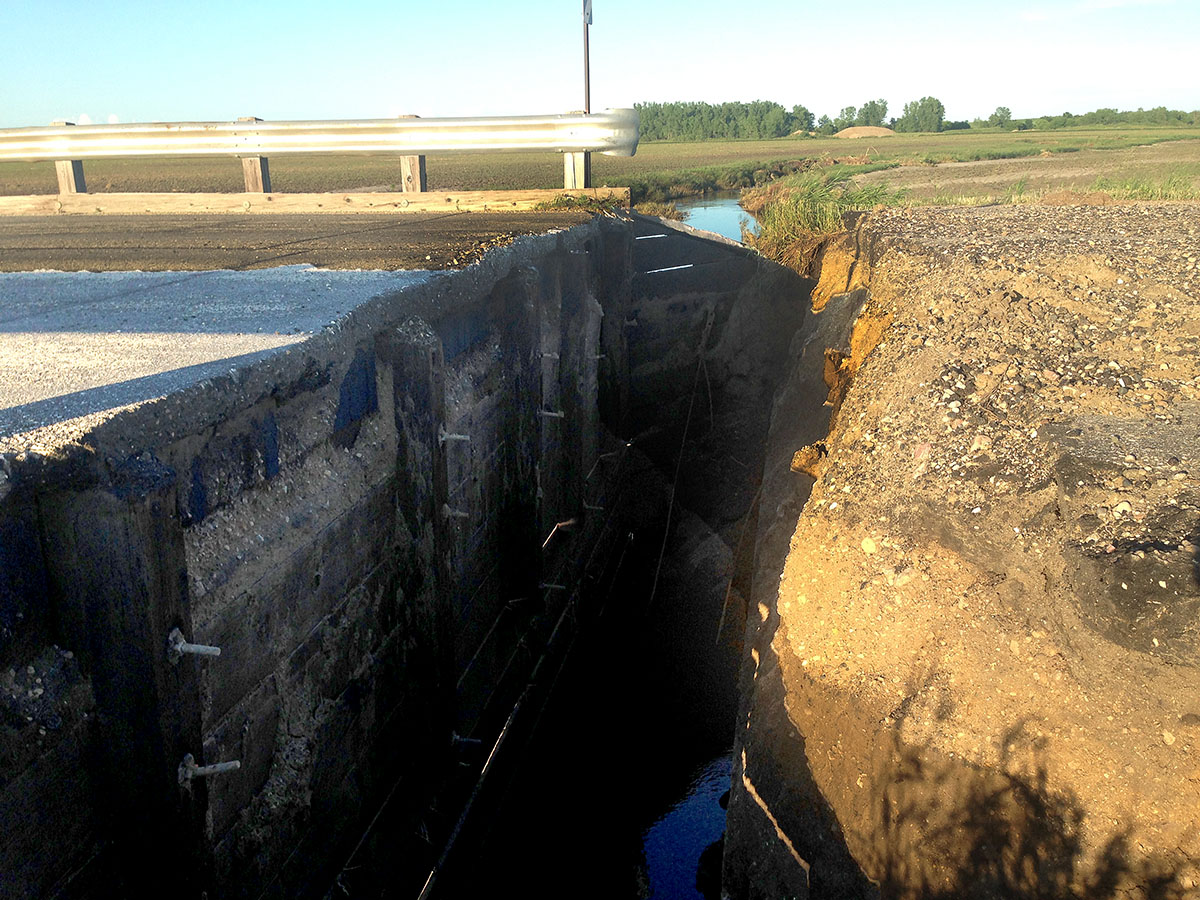 ,
,  ,
,  ,
,  ,
,  ,
,  ,
, 
As Rock County puts another decade in the review mirror, it’s helpful to reflect on major events — accomplishments, tragedies and community efforts that affected local residents and shaped their behaviors and leadership policies going into the next decade.
It’s cliché to talk about weather in Minnesota, but in the case of recent history, it’s fair to say extreme weather events had a major impact on the lives of local residents.
April 2013 ice storm
The April 2013 ice storm stands out as a particularly impactful event for its unusual occurrence and the sheer damage it caused.
Rock County residents are used to ice, snow, wind and rain, but this system moved in as a spring rain that turned to a slow freeze of an inch and a half of ice, followed by nearly 10 inches of snow and driving 40 mph wind.
These conditions were disastrous for trees and power lines, which bent and broke in communities all over the region.
Entire communities were without electricity for nearly a week, and some towns, Hills and Steen, for example, had no landline telephone service or emergency communication.
Downed utility poles — more than 150 in Rock County, snapped like toothpicks under the weight of ice — could be seen on rural roadways all over Rock County and the region.
That scenery was soon replaced by hundreds of utility workers with heavy equipment working around the clock to repair lines and restore power.
The drone of distant chain saws and the backup beeps of heavy equipment were common sounds all over Rock County and southwest Minnesota in the following days as people dug out from fallen trees and branches.
The Spring Storm of 2013 is most remembered for the toll on trees, many of which still bear the scars of damage nearly seven years later.
Thousands of trees of all species and sizes were decimated by the ice, snow and wind.
Hundreds were removed entirely, and countless more were trimmed and assessed for discard or keep.
Father’s Day flood of 2014
Flooding in Rock County isn’t uncommon, but the 2014 event was epic in both size and scope damage, tallying up to 20 inches of rain by the time it was over.
It started with a surprising downburst of rain in stormy weather in the first week of June that left local residents feeling grateful to have skirted a tornado and other damage experienced in the region.
But no one could have predicted the deluge Mother Nature had in store for the following days.
The weather on Saturday, June 14, started raising eyebrows that night when heavy rain became torrential rain. And didn’t stop.
A system had parked itself over southwest Minnesota and didn’t move for several hours.
This rain, arriving at an estimated rate of more than an inch per hour on the already drenched soil from previous heavy rainfall, quickly added up to trouble for Rock County and its inhabitants.
Another downburst Monday evening, June 16, further complicated the disaster.
Road ditches became raging rivers, sweeping cars off their wheels, and motorists found it impossible to navigate even a few miles in any direction. For a period of time, I-90 and state and major local roads were completely closed.
Homes that had never before suffered basement moisture acquired several inches in the lower levels, destroying carpet, furnishings and Sheetrock, along with irreplaceable family heirlooms in some cases.
Many residents suffered heartbreaking and financially burdensome losses.
Meanwhile, flood damage to public property prompted state and federal officials converging in Rock County to assess losses.
Rebuilding at the park
The June 2014 flood will be remembered as the one that blew out the Blue Mounds State Park dam, draining the man-made lake and forever altering the park’s recreational landscape.
Roaring water blew out 80 to 90 feet of the concrete spillway, up to the dam itself, which was built as a WPA project in 1940.
Flooding also eroded driveways and trails within the park, and 3 feet of water filled the lower level of the visitor center. The once-popular Blue Mounds swimming hole with its well-kept inviting beach had been reduced to a weedy mud puddle.
In the years following the disaster, community input meetings and studies led to the decision that the Blue Mounds lake would not be put back.
It was difficult for some to imagine, but the science made sense. Mother Nature had originally cultivated a meandering stream in that area, with wet marshes and tall grasses to provide habitat and protect water quality.
This is what state and federal planners decided to put back. By the end of the decade, a walk bridge was erected and the outlines of fishing areas and new trails could be detected.
A new water challenge arose in 2016 when E. coli was discovered in the park’s drinking water system.
After years of research and more than $300,000 to drill a new well, the problem persisted, meaning that campers couldn’t use the park water for anything but flushing toilets.
Finally, the state park found a water solution in the Lewis and Clark Regional Water System, another major headline of the decade.
Lewis and Clark Regional Water arrives
Water also dominated the decade’s news as the Star Herald chronicled what had become a 26-year quest to bring treated drinking water from the Missouri River aquifer to Luverne and 20 other communities in the tri-state area.
A ribbon-cutting event in March 2016 celebrated the arrival of water from Vermillion, South Dakota, to Luverne through the Lewis and Clark pipeline.
Red Arndt, an honored guest at Monday’s event, was part of the system’s early start in 1990 when he was Luverne’s water and wastewater supervisor.
“I’ve been waiting for this day for a long time — 26 years,” he told a small gathering of dignitaries under a tent near the Lewis and Clark meter building by the city power plant.
“We finally have water that will sustain the growth of Luverne for years to come and that will enable my kids and grandkids to stay here and have jobs here that are enabled by water.”
Luverne became the thirteenth member of twenty connected. When complete, the Lewis and Clark Rural Water System will provide treated water from the Missouri River aquifer to more than 300,000 people in the tri-state area.
Broadband reaches rural homes
For those who have long had adequate Internet access, it may not be a big deal that fiber-to-the-home broadband access is reaching rural Rock County.
But for many of the thousands of rural residents who have been without high-speed Internet, this was the biggest story of the decade.
In fact, rural broadband is often compared to rural electricity and phone service, in terms of far-reaching economic impact.
The service came to Rock County in 2016 by way of a $5 million state grant to bring fiber-to-the-premises service to rural residents in Rock County and the cities of Jasper (Rock County side), Hardwick, Beaver Creek, Magnolia and Kanaranzi.
Because of the increased costs due to the grant’s prevailing wage stipulations, the southeast portion of the county originally wouldn’t have received the service.
To bring the option to the entire county, commissioners opted to bond $1 million to match Alliance’s additional contribution.
Farming through the decade
The previous decade saw some of the best and worst times in the history of farming in Rock County in terms of commodity prices, land values, record yields and effects of weather.
Rapid growth of technology in agriculture affected everything from farm machinery to farm business management. In 2010 “auto-steer” technology in farm machinery was in its developmental stage and today it’s common in crop production. Precision farming methods now allow producers to more precisely apply crop fertilizer and chemicals, which is both more cost-effective and environmentally friendly.
The past decade saw increased focus on farming’s effect on the environment at the same time farmers are becoming increasingly aware that what’s good for the soil and water is good for their farming operations.
Laws required buffers to protect waterways, but cover crops and other soil preservation methods are becoming increasingly the norm as farmers seek to survive amid extreme weather events.
Land values increased sharply during the first few years of the past decade before declining in recent years. Land at the start of the decade was valued at an average $4,371 per tillable acre and reached a high of $8,716 per acre by the end of 2013, before declining to an average of $7,183 by the end of 2016.
In Rock County some of the highest recorded sales reached $16,200 per acre in 2012 and $14,900 per acre in 2013.
Midway through the decade, farmers were flush with cash, and the local economy also flourished, but the tide turned later in the decade.
Median net farm income for Minnesota farmers in 2018 was only $26,055, which was the lowest in the past 23 years of analyzing farm business management records.
It was the fifth year in a row of sub-par net farm income levels in the state, which was the first time that this has occurred since the 1980s, and analysts say 2019 data will continue this trend.
A small but growing number of local producers are ceasing operation or filing bankruptcy.
The Lake becomes a recreational hot spot
A bright spot in local news has been the developing story of The Lake, formerly known as the Creamery Pond in Luverne.
Over the past several years, local property owners Mike and Traci Davis with help from the city of Luverne and others, have cleaned up the grounds that feature a sandy beach, a dock, a fishing pier, a parking lot and many other inviting amenities.
The community now celebrates an annual fishing derby in February and a Fourth of July party and fireworks in the summer.
City leaders have invested in The Lake for the same reason they’ve invested in the Luverne Loop — to improve quality of life for residents.
The Loop
The Luverne Loop, when complete, will be 7 miles long, and it connects to the 6-mile Blue Mound Trail that carries hikers and bikers to the Blue Mounds State Park.
Phase 1, completed in 2016, is 1.5 miles from Veterans Memorial Pond across Highway 75 to the west edge of the city and then south along the school ball fields to Dodge Street.
Phase 2 is a 1.6-mile segment that continues south of Dodge Street past The Lake and then east past the ice arena to Highway 75.
Phases 1 and 2 circle the city’s northwest and west sides, currently ending at the intersection of Gabrielson Road at South Highway 75.
Phase 3 will complete the Loop and connect with the Blue Mound Trail at the intersection of East Main Street and Blue Mound Avenue.
Total Loop construction is estimated at more than $1.5 million, with a good share of the costs being covered by state and federal grants.
Sprucing up the town and its brand
The Loop and The Lake are part of the city’s overall goal of sprucing up its image and brand, which dominated headlines through the past decade.
After working with consultants, the city launched its “Luverne … Love the Life” logo in 2013. The signature heart and gray and red coloring soon began to appear on everything from stationary to street signs.
In 2016 it appeared on the newly painted water tower as a lighted sign for traffic to see from Highway 75, and new street banners boasted dozens of things to “love about Luverne,” including recreation, business, schools, etc.
Along with implementing its new brand, the city plugged away at improving the looks of the town.
Just in time for its 150thanniversary party in 2017, Luverne wrapped up its $122,000 Four Corners landscaping at the intersection of Highway 75 and Main Street.
The lighted flag park with benches is on the southeast corner; the northeast corner features a lighted sign; the northwest and southwest corners carry through the theme of red brick, Sioux quartzite boulders and grass and shrubs.
Similar work was completed the following year on East Main Street as a partnership with Take 16 Brewing Company.
Urban landscape improvements continued at The Lake and Rotary Park and include signage — such as the signature blue-and-red wayfinding signs — around town.
This work comes on the heels of the city’s $3 million South Highway 75 improvements that brought green boulevards, sidewalks and a new three-lane road surface.
Infrastructure improvements this decade will benefit the community for the next 50-plus years
Some of the biggest investments in Luverne over the past years are improvements most people never see or think about.
Industrial park:Over the past several years, the city’s southwest side has transformed from a cornfield into a modern industrial park with $11 million worth of new infrastructure, including a 10-ton road and access to water, sewer and electricity.
Electricity:A $4 million electrical substation near the CHS fuel pumps will accommodate future development in Luverne and bolster the city’s existing electrical system.
The west substation is located near The Lake by the DenHerder construction shop. The east substation is located near the city Public Works shops behind the former Casey’s East building.
The two have backed each other up when one isn’t functioning, but adding the new south substation will provide needed coverage for these times that were previously covered by one.
Wastewater treatment:Meanwhile, Luverne wastewater treatment plant is currently undergoing $14 million in upgrades to improve and replace many components that were over 50 years old.
All of these investments will put the city on solid ground for industrial growth for decades to come.
Premium Iowa Pork
The first industry to benefit from the wastewater treatment plant upgrades will be Premium Iowa Pork, which purchased the former Gold’n Plump facility in 2018.
The Hospers, Iowa, pork processor plans to slaughter up to 2,500 antibiotic-free hogs per day in the former Gold’n Plump facility. Production is expected to start in spring of 2020.
The company is retrofitting the existing 78,000-square-foot facility and expanding it another 12,500 square feet for an estimated $30 million investment.
The company plans to hire 250 production workers (at $13 to $20 per hour) in Luverne. That number could increase to more than 300 employees, depending on growth.
In addition, the company paid $6.76 million for necessary upgrades to Luverne’s wastewater facilities due to the plant’s sewage load into the city’s system.
Where will everyone live?
A 2016 study of Luverne’s housing supply revealed severe shortages even without Premium Iowa Pork workers.
An updated study in 2019 showed the need for 267 more housing units through 2030, mostly in senior living options. It reaffirmed city efforts to create opportunities for development.
In addition to town homes already occupied on East Barck Street and on Roundwind Avenue east of the pool, a four-plex unit is nearly complete on East Barck Street and 15 lots are prepared for twin home and single family construction on the Uithoven Addition on the west side of Luverne.
Another three twin homes can go up on the Reisch Addition lots north of Rock County Opportunities, and the recent purchase of Lynn Lopau’s acreage will allow for additional twin homes and single-family houses to be constructed after 2021.
While the housing study shows a distinct need for mid-income starter-type homes in the $150,000 range, the hope is that this housing stock will open up as residents leave these homes to move into twin home options.
Changes in the Luverne School District
Luverne Middle-High School will move into the next decade amid its largest construction project to date.
Voters approved a $31 million bond referendum in November 2017 to renovate and upgrade the building to correct deficiencies in both space and infrastructure.
The project includes a new commons and performing arts center that will connect the elementary and middle-high school. End date for construction is fall of 2021.
This past year saw the return of a middle school principal, a position combined since 2005.
Former teacher Jason Phelps returned to LHS as principal after spending five years as elementary principal at Hills-Beaver Creek.
The combined position used to be that of high school principal Ryan Johnson, who joined the district in 2010. He continues as high school principal.
Donna Judson filled the combined position for five years after former middle-high school principal Gary Fisher became superintendent in 2005 after Vince Schaefer retired.
Fisher was superintendent until his retirement in 2015, when current superintendent Craig Oftedahl was hired.
Luverne and Hills-Beaver Creek were among 25 southwest Minnesota schools involved in a three-year flexible learning yearcalendar beginning in 2010 and extending into 2016.
FLY allowed districts to begin school before Labor Day to increase the amount of class time and preparation for the spring standardized tests.
FLY ended in the fall of 2016.
H-BC district builds new high school; climbs out of statutory operating debt
The decade from 2009 to 2019 was eventful for the residents of the Hills-Beaver Creek School District, which began 2010 by advocating for a new sixth- through 12th-grade school in Hills.
At the March special election, district voters stood in line and cast a total of 893 votes, with 70 percent approving the new $10 million bond.
The new school was constructed in 2011 on property on the northwest edge of Hills.
However, the following year brought turmoil as the district found itself in financial straits after an ending June 30, 2011, audit revealed a general fund operating with balance below state recommendations.
In early 2012, Superintendent Dave Deragisch (2001 to 2012) received notice from the state to have a multi-year plan in place by Jan. 31, 2012, to restore finances.
The shortfall (estimated to be just under $200,000) was created by three factors: mishandling of construction bills, years of deficit spending in the health and safety fund, and delayed state aid.
Current Superintendent Todd Holthaus, who was the district elementary principal since 2003, became superintendent July 1, 2012. Deragisch resigned in February.
Holthaus worked with superintendent interim Superintendent Herb Benz to formulated a budget plan that brought the district out of statutory operating debt a year after taking the helm.
The progress was noticed by Matt Taubert, whose firm Meulebroeck, Taubert & Co. began auditing the books in 2012.
Taubert commended the district at their last meeting of 2019 for how quickly it bounced back from a minus $224,749 balance in 2012.
“In eight years, the district has increased its fund balance by $3.7 million,” he said. “It’s very impressive from my standpoint.”


